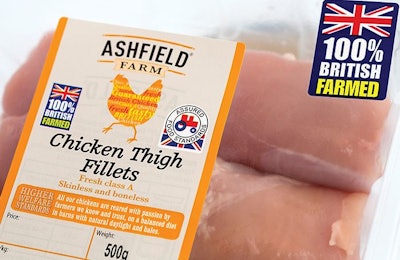
Red Tractor, judged to be the world’s highest-performing broad-coverage farm assurance scheme by an independent benchmarking study this year, has launched two new initiatives to further increase confidence in its mark.
Beginning in June, Red Tractor will carry out unannounced inspections on any poultry farms deemed to have shown a poor compliance record since the new risk-based inspection scheme was introduced at the start of April.
After a routine inspection, if a member is classified as higher risk, an additional spot check will be carried out at the farmer’s expense, and the farmer will be notified by their certification body. Poor performers will see an increase in these unannounced inspections and producers could eventually have their membership suspended, or ultimately withdrawn.
June also will bring the introduction of Red Tractor’s "Farmed with Care" confidential phone line that allows whistleblowers the opportunity to contact Red Tractor anonymously. This hotline applies to whole supply chain and is a further tool with which to root out non-conformity with the standards.
Scheme is second to none
But while Red Tractor continues to find ways to maintain and improve standards across the industry, the results of a recent international benchmarking study indicate that the breadth and depth of this food standards scheme are second to none, particularly in the areas of traceability and food safety.
The research, conducted over six months by independent Nuffield scholar Jonathan Birnie, compared Red Tractor with schemes from competing countries that have a significant presence in their home market. In the chicken sector, these schemes included Bord Bia; Global GAP; RSPCA Assured; the Soil Association; QS Germany; Beter Leven 1, 2 & 3; IKB; and Global Animal Partnership (GAP) 5-Step Programme.
World-leading poultry standards
In this sector, the study highlighted Red Tractor’s antibiotic monitoring and traceability and assurance chain (breeder, hatchery, broiler farms, catching, transport, abattoir and processor) as "world-leading." It also found its stocking density and transport times to be comparable to broad coverage schemes.
However, the findings also revealed that lighting, while acceptable in Red Tractor, is behind several other schemes; that four higher welfare schemes specify slower-growing breeds; and that stocking density is higher than, and transport times behind, higher welfare schemes.
Additionally, while the results differ according to animal species, welfare-focused schemes were generally found to have higher animal welfare requirements.
In its defense, Red Tractor points out that “single-issue schemes have the potential to improve one area, usually for a small number of farms, while broad schemes have the potential to improve many areas, for a much larger number of farms.”
Addressing shortfalls
Yet Red Tractor acknowledges that, to become the flagship for British food and farming, it needs to address some of these shortfalls.
In a bid to substantially increase the breadth of its food chain assurance regime, it has announced the development of new modular standards in areas such as higher animal welfare, organics and environmental enhancement. Other areas, yet to be announced, are also said to be under consideration.
Raising awareness
As the U.K. approaches Brexit, the assurance scheme’s chief executive Jim Moseley has warned that increasing confidence in Red Tractor is vital.
To this end – in a bid to increase consumer awareness of the mark and influence purchasing decisions – Red Tractor is funding its second wave of television advertising.
Last year’s eight-week advertising campaign, which included the organization’s first-ever TV advertisement, led to a 5% increase in the number of shoppers who said the logo would make them choose a Red Tractor product over the cheapest one – a rise from 36% to 41%. According to the Agriculture & Horticulture Development Board, this equates to an additional 1.4 million shoppers.
As well as the spike in purchasing intent, YouGov, which carried out the poll before and after the campaign, found that the number of shoppers associating the logo with "traceable food from farms to pack" nearly doubled to 62%.
This year, the TV advertising campaign ran for five weeks, to the end of April, and there are plans for another wave in late summer/early autumn.
Increasing consumer understanding of the mark remains pivotal. But as Moseley warned farmers: the only way the scheme can maintain its hard-earned integrity is if assured farms remain 100% compliant 365 days of the year.

Consumer awareness through television advertising is proving pivotal in influencing purchasing decisions. (Courtesy Red Tractor)
















